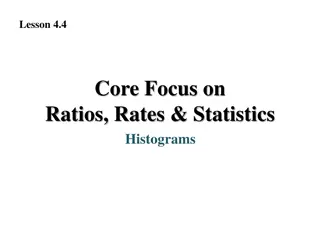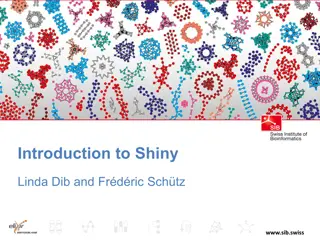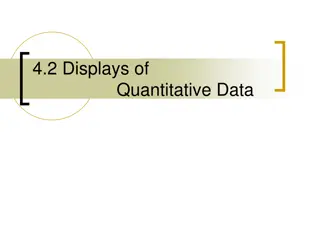Understanding Histograms in Displaying Quantitative Data
Learn how to create and interpret histograms in displaying quantitative data. This lesson covers making histograms, interpreting distributions, and comparing data sets. Understand the importance of grouping data values and creating equal-width intervals for a clearer visualization. Explore the process of making a histogram step by step, including choosing intervals, creating a frequency table, scaling axes, and drawing bars. Apply these techniques to analyze data effectively and derive meaningful insights.
Download Presentation

Please find below an Image/Link to download the presentation.
The content on the website is provided AS IS for your information and personal use only. It may not be sold, licensed, or shared on other websites without obtaining consent from the author. Download presentation by click this link. If you encounter any issues during the download, it is possible that the publisher has removed the file from their server.
E N D
Presentation Transcript
Analyzing One-Variable Data Lesson 1.5 Displaying Quantitative Data: Histograms Statistics and Probability with Applications, 3rdEdition Starnes, Bedford Freeman Worth Publishers
Displaying Quantitative Data: Histograms Learning Targets After this lesson, you should be able to: Make histograms of quantitative data. Interpret histograms. Compare distributions of quantitative data with histograms. Statistics and Probability with Applications, 3rd Edition 2 2
Displaying Quantitative Data: Histograms You can use a dotplot or stemplot to display quantitative data. Both graphs show every individual data value. For large data sets, this can make it difficult to see the overall pattern in the graph. We often get a cleaner picture of the distribution by grouping nearby values together. Doing so allows us to make a new type of graph: a histogram. Histogram A histogram shows each interval as a bar. The heights of the bars show the frequencies or relative frequencies of values in each interval. Statistics and Probability with Applications, 3rd Edition 3 3
Displaying Quantitative Data: Histograms (a) Dotplot and (b) histogram of the duration (in minutes) of 220 eruptions of the Old Faithful geyser. Statistics and Probability with Applications, 3rd Edition 4 4
Displaying Quantitative Data: Histograms How to Make a Histogram 1. Choose equal-width intervals that span the data. Five intervals is a good minimum. 2. Make a table that shows the frequency (count) or relative frequency (percent or proportion) of individuals in each interval. 3. Draw and label the axes. Put the name of the quantitative variable under the horizontal axis. To the left of the vertical axis, indicate if the graph shows the frequency or relative frequency of individuals in each interval. 4. Scale the axes. Place equally spaced tick marks at the smallest value in each interval along the horizontal axis. On the vertical axis, start at 0 and place equally spaced tick marks until you exceed the largest frequency or relative frequency in any interval. 5. Draw bars above the intervals. Make the bars equal in width and leave no gaps between them. The height of each bar corresponds to the frequency or relative frequency of individuals in that interval. An interval with no data values will appear as a bar of height 0 on the graph. Statistics and Probability with Applications, 3rd Edition 5 5
What can we learn from the past? What can we learn from the past? Making a histogram Making a histogram PROBLEM: Ancient Egyptian embalming techniques and the climate in Egypt can preserve bodies of the dead remarkably well. Researchers made measurements of 30 Egyptian male skulls that date from about 4000 BCE. One variable they recorded was the maximum width of the skull in millimeters, shown in the table. Make a frequency histogram of these data. 131 125 131 119 136 138 139 125 131 134 129 134 126 132 141 Skull Width 131 135 132 139 132 126 135 134 128 130 138 128 127 131 124 SOLUTION: 12 10 Interval Frequency Number of skulls 8 115 to <120 1 6 120 to <125 1 125 to <130 8 4 130 to <135 12 2 135 to <140 7 0 140 to <145 1 115 120 125 130 135 140 145 Skull width (mm) Statistics and Probability with Applications, 3rd Edition 6 6
Displaying Quantitative Data: Histograms The choice of intervals in a histogram can affect the appearance of a distribution. The figure below shows two different histograms of the foreign-resident data. The one on the left uses the intervals of width 5 from the previous example. The one on the right uses intervals half as wide: 0 to <2.5, 2.5 to <5, and so on. Histograms with more intervals show more detail but may have a less clear overall pattern. Statistics and Probability with Applications, 3rd Edition 7 7
Is it all just in your head? Is it all just in your head? Interpreting a histogram Interpreting a histogram PROBLEM: Another histogram of the ancient Egyptian skulls is shown, but with interval widths of 3 millimeters. The intervals are 118 to <121, 121 to <124, and so on. Use this histogram and the one from the previous example to answer these questions. 9 8 7 Number of skulls 6 5 4 3 2 1 0 118 121 124 127 130 133 136 139 142 Skull width (mm) (a) What percent of ancient Egyptian males in this sample have skull widths of at least 133 millimeters? (b) Describe the shapes of the two graphs. (c) What feature of the distribution is clearly noticeable in the second histogram but not in the first? Statistics and Probability with Applications, 3rd Edition 8 8
Is it all just in your head? Is it all just in your head? Interpreting a histogram Interpreting a histogram 9 8 7 Number of skulls 6 5 4 3 2 1 0 118 121 124 127 130 133 136 139 142 Skull width (mm) (a) What percent of ancient Egyptian males in this sample have skull widths of at least 133 millimeters? (5 + 3 + 3)/30 or 36.7% of skulls were at least 133 mm wide. (b) Describe the shapes of the two graphs. In both histograms, the distribution of skull widths appears to be approximately symmetric. The original histogram shows a peak between 130 and 135 mm, while the second histogram shows the peak between 130 and 133 mm. (c) What feature of the distribution is clearly noticeable in the second histogram but not in the first? There is a noticeable unusual value (119 mm) that appears in the second histogram but not in the first histogram. This value is potentially an outlier. Statistics and Probability with Applications, 3rd Edition 9 9
Displaying Quantitative Data: Histograms What are we actually doing when we make a histogram? Statistics and Probability with Applications, 3rd Edition 10 10
Displaying Quantitative Data: Histograms Histograms can be used to compare the distribution of a quantitative variable in two or more groups. It s a good idea to use relative frequencies (percents or proportions) when comparing, especially if the groups have different sizes. Be sure to use the same intervals when making comparative histograms so the graphs can be drawn using a common horizontal axis scale. Is it true that students who graduate from high school earn more money than students who do not graduate from high school? Statistics and Probability with Applications, 3rd Edition 11 11
Which is the stronger picker Which is the stronger picker- -upper? Comparing distributions with histograms Comparing distributions with histograms PROBLEM: In commercials for Bounty paper towels, the manufacturer claims that they are the quicker picker-upper, but are they also the stronger picker upper? Two of Mr. Tabor s statistics students, Wesley and Maverick, decided to find out. They selected a random sample of 30 Bounty paper towels and a random sample of 30 generic paper towels and measured their strength when wet. To do this, they uniformly soaked each paper towel with 4 ounces of water, held two opposite edges of the paper towel, and counted how many quarters each paper towel could hold until ripping, alternating brands. Compare the distributions as revealed in the following histograms. upper? Statistics and Probability with Applications, 3rd Edition 12 12
Which is the stronger picker Which is the stronger picker- -upper? Comparing distributions with histograms Comparing distributions with histograms upper? SOLUTION: Shape: The distribution of Bounty paper towels is slightly left-skewed, while the distribution of generic paper towels is roughly symmetric. Outliers: There do not appear to be any outliers in either distribution. Center: The center of the Bounty paper towels (around 116 quarters) distribution is higher than the center of the generic paper towels (around 90 quarters) distribution, indicating that Bounty paper towels can hold more weight. Spread (Variability): Both distributions appear to have about the same amount of variability. Statistics and Probability with Applications, 3rd Edition 13 13
LESSON APP 1.5 How old are U.S. presidents? The table gives the ages of the first 44 U.S. presidents when they took office. 1. Make a frequency histogram of the data using intervals of width 4 starting at age 40. 2. Describe the shape of the distribution. 3. What percent of presidents took office before the age of 60? Statistics and Probability with Applications, 3rd Edition 14 14
LESSON APP 1.5 How old are U.S. presidents? Statistics and Probability with Applications, 3rd Edition 15 15
Displaying Quantitative Data: Histograms Learning Targets After this lesson, you should be able to: Make histograms of quantitative data. Interpret histograms. Compare distributions of quantitative data with histograms. Statistics and Probability with Applications, 3rd Edition 16 16























